TOYOTA GR86 2022 (in English) Repair Manual
Manufacturer: TOYOTA, Model Year: 2022, Model line: GR86, Model: TOYOTA GR86 2022Pages: 582, PDF Size: 86.38 MB
Page 61 of 582
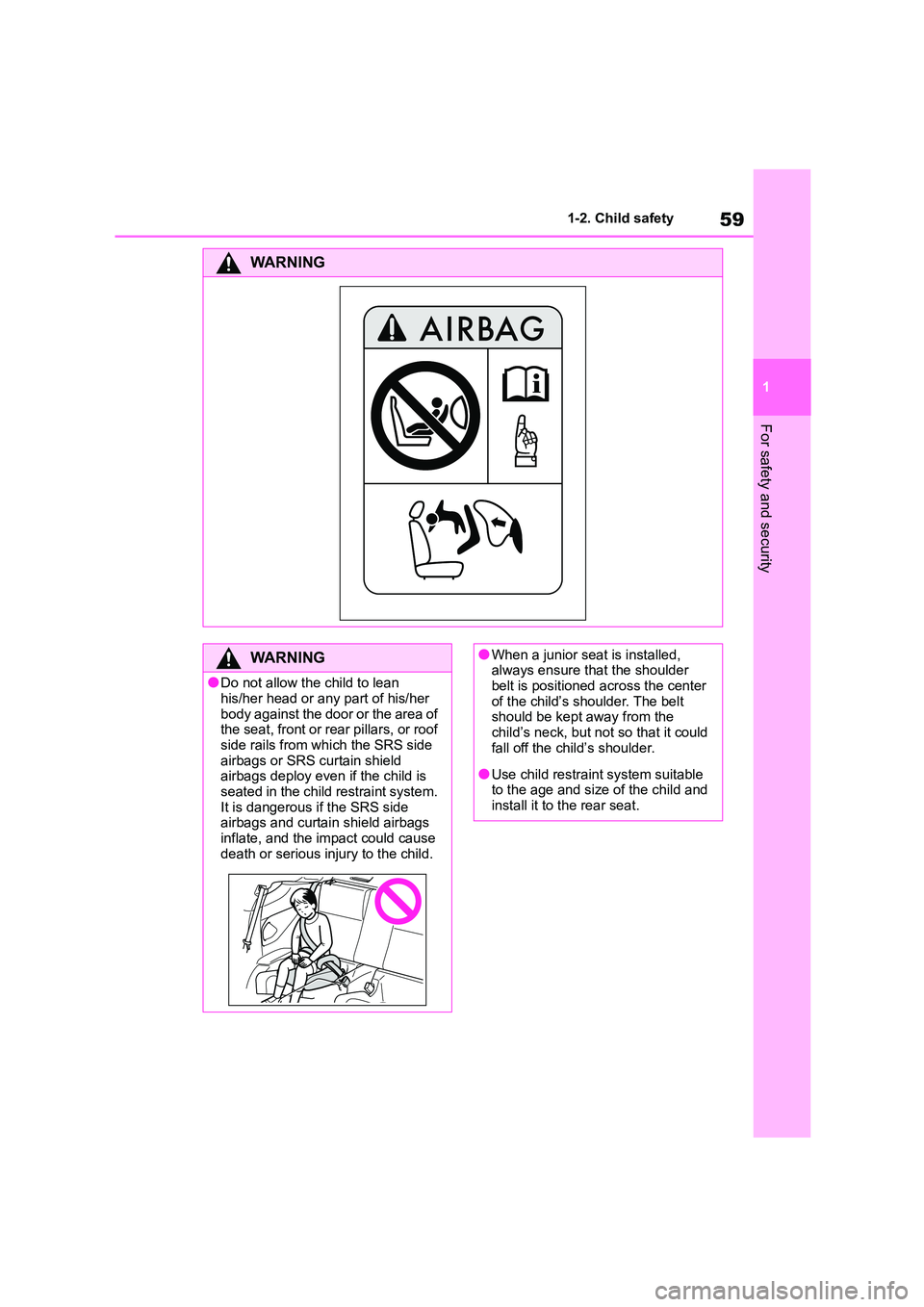
59
1
1-2. Child safety
For safety and security
WA R N I N G
WA R N I N G
●Do not allow the child to lean
his/her head or any part of his/her body against the door or the area of
the seat, front or rear pillars, or roof
side rails from which the SRS side airbags or SRS curtain shield
airbags deploy even if the child is
seated in the child restraint system. It is dangerous if the SRS side
airbags and curtain shield airbags
inflate, and the impact could cause death or serious injury to the child.
●When a junior seat is installed,
always ensure that the shoulder belt is positioned across the center
of the child’s shoulder. The belt
should be kept away from the
child’s neck, but not so that it could fall off the child’s shoulder.
●Use child restrain t system suitable to the age and size of the child and
install it to the rear seat.
Page 62 of 582
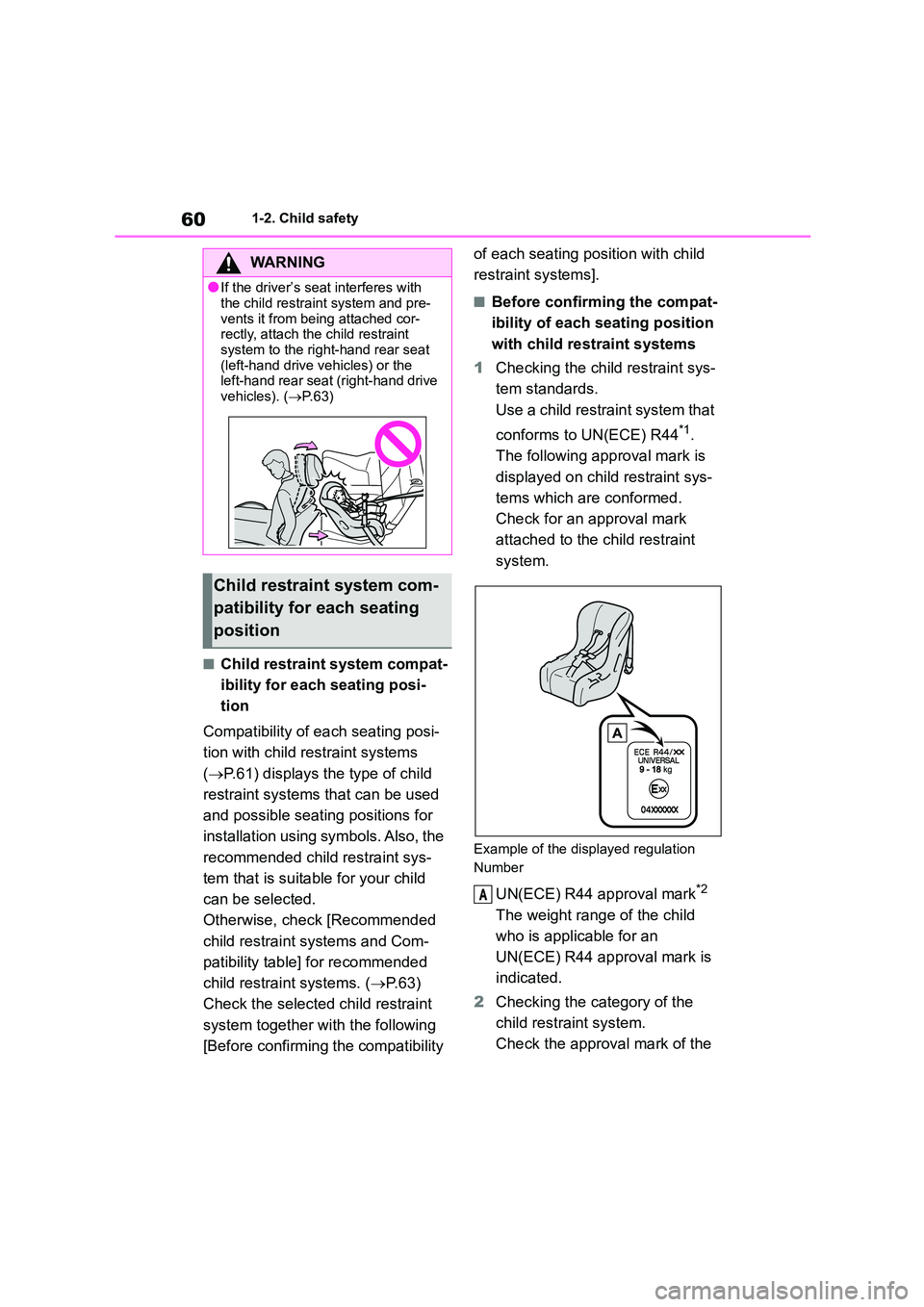
601-2. Child safety
■Child restraint system compat-
ibility for each seating posi-
tion
Compatibility of eac h seating posi-
tion with child restraint systems
( P.61) displays the type of child
restraint systems that can be used
and possible seating positions for
installation using symbols. Also, the
recommended child restraint sys-
tem that is suitable for your child
can be selected.
Otherwise, check [Recommended
child restraint systems and Com-
patibility table] for recommended
child restraint systems. ( P. 6 3 )
Check the selected child restraint
system together with the following
[Before confirming the compatibility
of each seating position with child
restraint systems].
■Before confirming the compat-
ibility of each seating position
with child restraint systems
1 Checking the child restraint sys-
tem standards.
Use a child restraint system that
conforms to UN(ECE) R44*1.
The following approval mark is
displayed on child restraint sys-
tems which are conformed.
Check for an approval mark
attached to the child restraint
system.
Example of the displayed regulation
Number
UN(ECE) R44 approval mark*2
The weight range of the child
who is applicable for an
UN(ECE) R44 approval mark is
indicated.
2 Checking the category of the
child restraint system.
Check the approval mark of the
WA R N I N G
●If the driver’s seat interferes with
the child restraint system and pre-
vents it from being attached cor- rectly, attach the child restraint
system to the righ t-hand rear seat
(left-hand drive vehicles) or the left-hand rear seat (right-hand drive
vehicles). ( P.63)
Child restraint system com-
patibility for each seating
position
A
Page 63 of 582
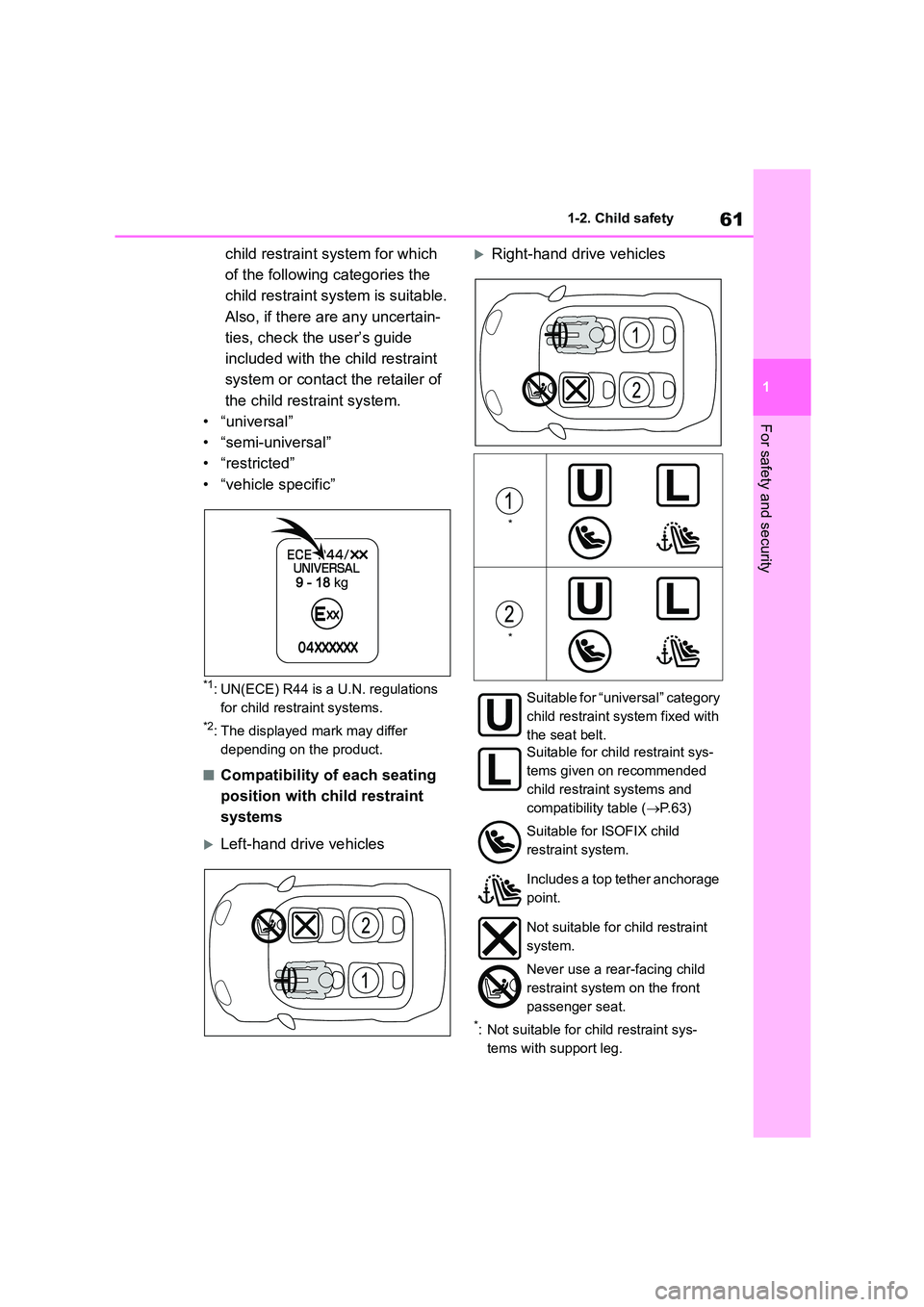
61
1
1-2. Child safety
For safety and security
child restraint system for which
of the following categories the
child restraint system is suitable.
Also, if there are any uncertain-
ties, check the user’s guide
included with th e child restraint
system or contact the retailer of
the child rest raint system.
• “universal”
• “semi-universal”
• “restricted”
• “vehicle specific”
*1: UN(ECE) R44 is a U.N. regulations
for child restraint systems.
*2: The displayed mark may differ
depending on the product.
■Compatibility of each seating
position with child restraint
systems
Left-hand drive vehicles
Right-hand drive vehicles
*: Not suitable for child restraint sys-
tems with support leg.
*
*
Suitable for “universal” category
child restraint system fixed with
the seat belt.
Suitable for child restraint sys-
tems given on recommended
child restraint systems and
compatibility table ( P. 6 3 )
Suitable for ISOFIX child
restraint system.
Includes a top tether anchorage
point.
Not suitable for child restraint
system.
Never use a rear-facing child
restraint system on the front
passenger seat.
Page 64 of 582
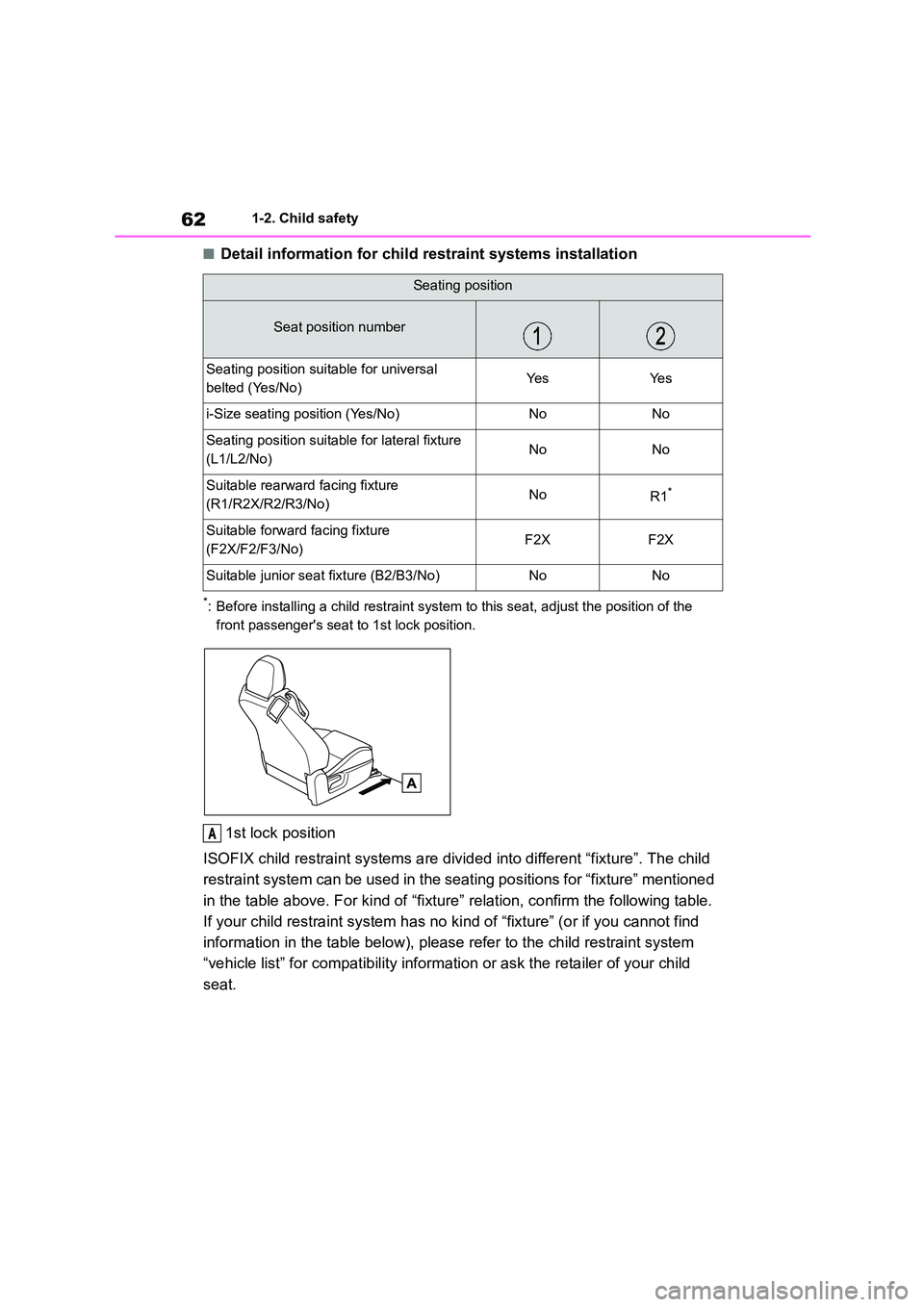
621-2. Child safety
■Detail information for child restraint systems installation
*: Before installing a child restraint system to this seat, adjust the position of the
front passenger's seat to 1st lock position.
1st lock position
ISOFIX child restraint systems are divid ed into different “fixture”. The child
restraint system can be used in the se ating positions for “fixture” mentioned
in the table above. For kind of “fixtu re” relation, confirm the following table.
If your child restraint system has no ki nd of “fixture” (or if you cannot find
information in the table below), please refer to the child restraint system
“vehicle list” for compatib ility information or ask the retailer of your child
seat.
Seating position
Seat position number
Seating position suitable for universal
belted (Yes/No)Ye sYe s
i-Size seating position (Yes/No)NoNo
Seating position suitable for lateral fixture
(L1/L2/No)NoNo
Suitable rearward facing fixture
(R1/R2X/R2/R3/No)NoR1*
Suitable forward facing fixture
(F2X/F2/F3/No)F2XF2X
Suitable junior seat fixture (B2/B3/No)NoNo
A
Page 65 of 582
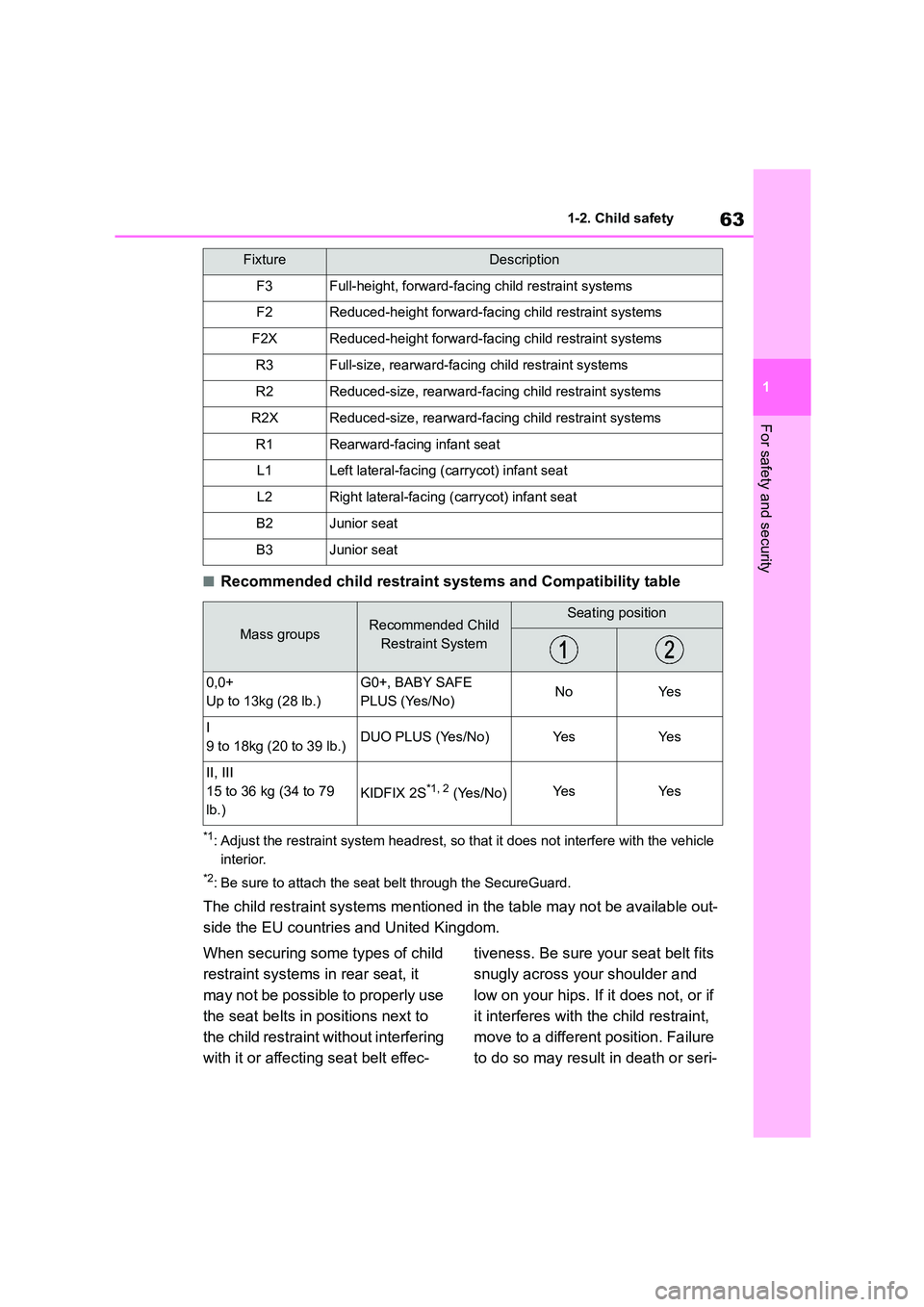
63
1
1-2. Child safety
For safety and security
■Recommended child restraint systems and Compatibility table
*1: Adjust the restraint system headrest, so that it does not interfere with the vehicle
interior.
*2: Be sure to attach the seat belt through the SecureGuard.
The child restraint systems mentioned in the table may not be available out-
side the EU countries and United Kingdom.
When securing some types of child
restraint systems in rear seat, it
may not be possible to properly use
the seat belts in positions next to
the child restraint without interfering
with it or affecting seat belt effec-
tiveness. Be sure your seat belt fits
snugly across your shoulder and
low on your hips. If it does not, or if
it interferes with the child restraint,
move to a different position. Failure
to do so may result in death or seri-
FixtureDescription
F3Full-height, forward-faci ng child restraint systems
F2Reduced-height forward-facing child restraint systems
F2XReduced-height forward-facing child restraint systems
R3Full-size, rearward-facing child restraint systems
R2Reduced-size, rearward-facing child restraint systems
R2XReduced-size, rearward-facing child restraint systems
R1Rearward-facing infant seat
L1Left lateral-facing (carrycot) infant seat
L2Right lateral-facing (carrycot) infant seat
B2Junior seat
B3Junior seat
Mass groupsRecommended Child
Restraint System
Seating position
0,0+
Up to 13kg (28 lb.)
G0+, BABY SAFE
PLUS (Yes/No)NoYe s
I
9 to 18kg (20 to 39 lb.)DUO PLUS (Yes/No)Ye sYe s
II, III
15 to 36 kg (34 to 79
lb.)
KIDFIX 2S*1, 2 (Yes/No)Ye sYe s
Page 66 of 582
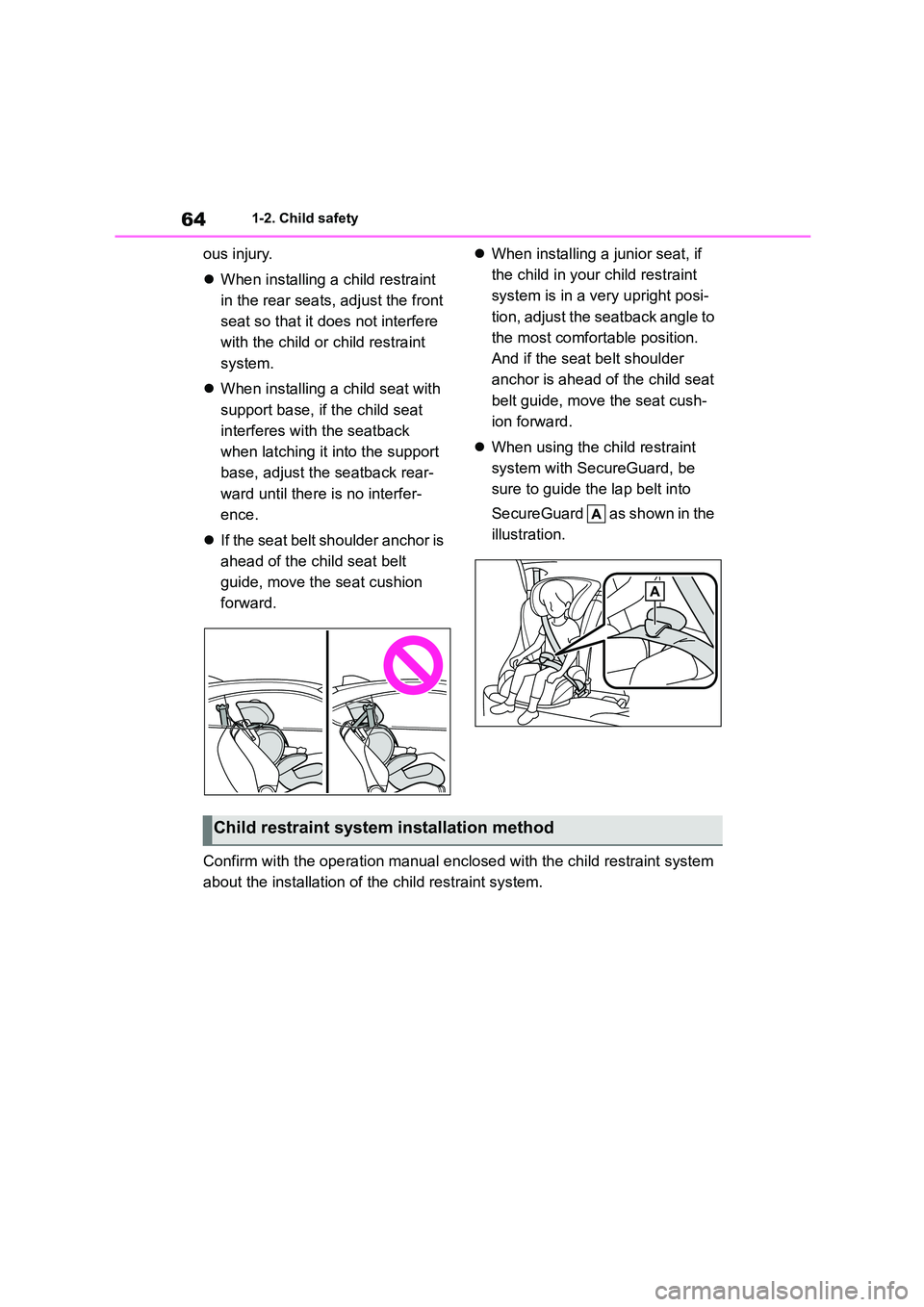
641-2. Child safety
ous injury.
When installing a child restraint
in the rear seats, adjust the front
seat so that it does not interfere
with the child or child restraint
system.
When installing a child seat with
support base, if the child seat
interferes with the seatback
when latching it into the support
base, adjust the seatback rear-
ward until there is no interfer-
ence.
If the seat belt shoulder anchor is
ahead of the child seat belt
guide, move the seat cushion
forward.
When installing a junior seat, if
the child in your child restraint
system is in a very upright posi-
tion, adjust the seatback angle to
the most comfortable position.
And if the seat belt shoulder
anchor is ahead of the child seat
belt guide, move the seat cush-
ion forward.
When using the child restraint
system with SecureGuard, be
sure to guide th e lap belt into
SecureGuard as shown in the
illustration.
Confirm with the operati on manual enclosed with the child restraint system
about the installation of the child restraint system.
Child restraint system installation method
Page 67 of 582
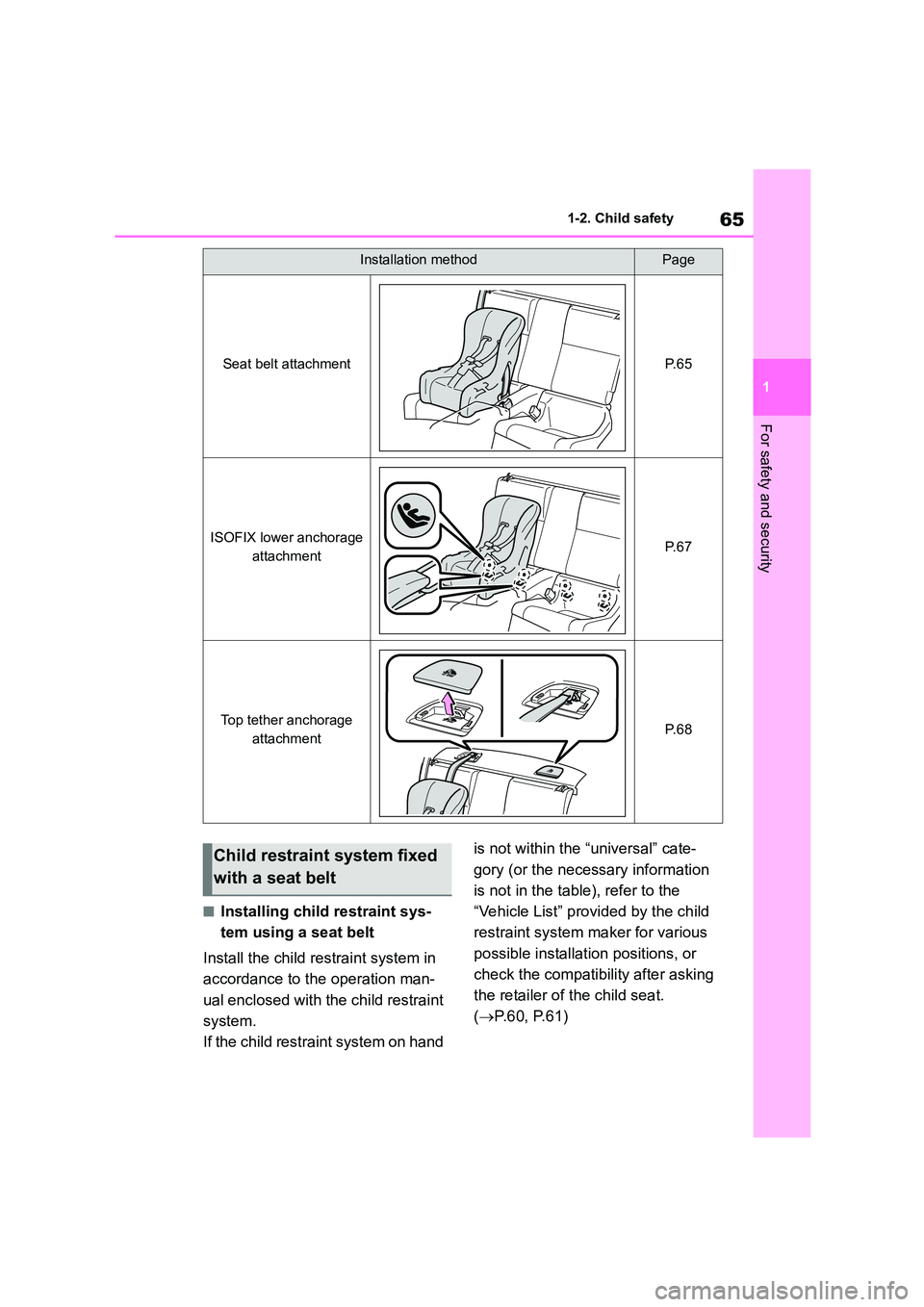
65
1
1-2. Child safety
For safety and security
■Installing child restraint sys-
tem using a seat belt
Install the child re straint system in
accordance to the operation man-
ual enclosed with the child restraint
system.
If the child restraint system on hand
is not within the “universal” cate-
gory (or the necessary information
is not in the table), refer to the
“Vehicle List” provided by the child
restraint system maker for various
possible installation positions, or
check the compatibility after asking
the retailer of the child seat.
( P. 6 0 , P. 6 1 )
Installation methodPage
Seat belt attachmentP. 6 5
ISOFIX lower anchorage
attachmentP. 6 7
Top tether anchorage
attachmentP. 6 8
Child restraint system fixed
with a seat belt
Page 68 of 582
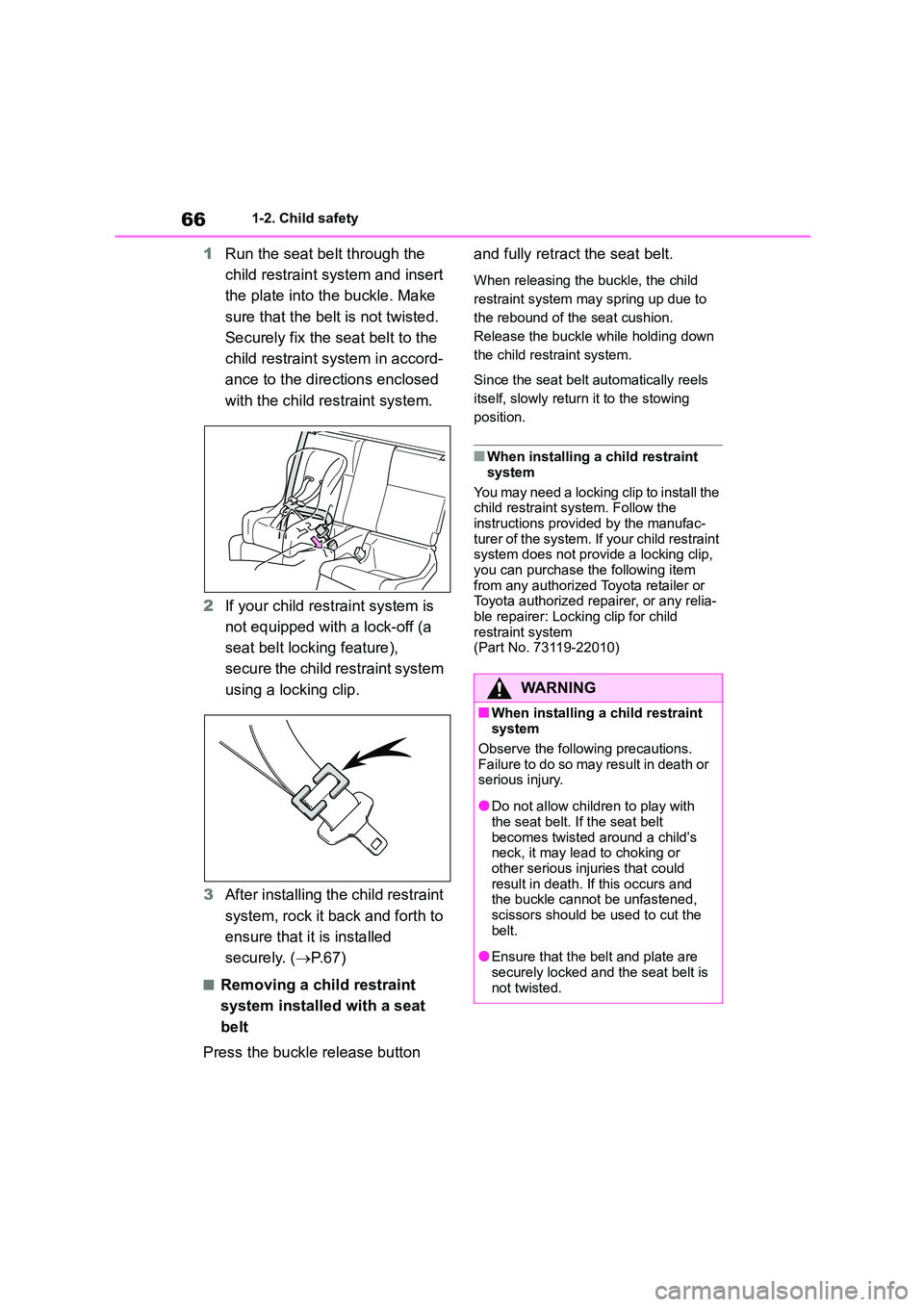
661-2. Child safety
1Run the seat belt through the
child restraint system and insert
the plate into th e buckle. Make
sure that the belt is not twisted.
Securely fix the seat belt to the
child restraint s ystem in accord-
ance to the directions enclosed
with the child restraint system.
2 If your child restraint system is
not equipped with a lock-off (a
seat belt locking feature),
secure the child restraint system
using a locking clip.
3 After installing the child restraint
system, rock it back and forth to
ensure that it is installed
securely. ( P. 6 7 )
■Removing a child restraint
system installed with a seat
belt
Press the buckle release button
and fully retract the seat belt.
When releasing the buckle, the child
restraint system may spring up due to
the rebound of the seat cushion.
Release the buckle while holding down
the child restraint system.
Since the seat belt automatically reels
itself, slowly return it to the stowing
position.
■When installing a child restraint
system
You may need a locking clip to install the child restraint system. Follow the
instructions provided by the manufac-
turer of the system. If your child restraint system does not prov ide a locking clip,
you can purchase the following item
from any authorized Toyota retailer or Toyota authorized repairer, or any relia-
ble repairer: Locking clip for child
restraint system (Part No. 73119-22010)
WA R N I N G
■When installing a child restraint
system
Observe the following precautions. Failure to do so may result in death or
serious injury.
●Do not allow children to play with
the seat belt. If the seat belt
becomes twisted around a child’s neck, it may lead to choking or
other serious injuries that could
result in death. If this occurs and the buckle cannot be unfastened,
scissors should be used to cut the
belt.
●Ensure that the belt and plate are
securely locked and the seat belt is not twisted.
Page 69 of 582

67
1
1-2. Child safety
For safety and security
■ISOFIX lower anchorages
(ISOFIX child restraint system)
Lower anchorages are provided for
the each rear seats. (Buttons dis-
playing the location of the anchor-
ages are attached to the seats.)
■Installation with ISOFIX lower
anchorage (ISOFIX child
restraint system)
Install the child re straint system in
accordance to the operation man-
ual enclosed with the child restraint
system.
If the child restraint system on hand
is not within the “universal” cate-
gory (or the necessary information
is not in the table), refer to the
“Vehicle List” provided by the child
restraint system maker for various
possible installation positions, or
check the compatibility after asking
the retailer of the child seat.
( P. 6 0 )
1 Check the positions of the exclu-
sive fixing bars, and install the
child restraint system to the
seat.
The bars are installed in the clearance.
2 After installing the child restraint
system, rock it back and forth to
ensure that it is installed
securely. ( P. 6 7 )
WA R N I N G
●Shake the child restraint system left
and right, and forward and back-
ward to ensure that it has been securely installed.
●After securing a child restraint sys-tem, never adjust the seat.
●When a junior seat is installed,
always ensure that the shoulder belt is positioned across the center
of the child’s shoulder. The belt
should be kept away from the child’s neck, but not so that it could
fall off the child’s shoulder.
●Follow all installation instructions
provided by the child restraint sys-
tem manufacturer.
Child restraint system fixed
with an ISOFIX lower
anchorage
Page 70 of 582

681-2. Child safety
■Top tether anchorages
Top tether anchorages are provided
for the each rear seat.
Use top tether anchorages when
fixing the top strap.
Top tether anchorages
To p s t r a p
■Fixing the top strap to the top
tether anchorages
Install the child re straint system in
accordance to the operation man-
ual enclosed with the child restraint
system.
Open the top tether anchorages
cover, latch the hook onto the top
tether anchorages and tighten the
top strap.
Make sure the top strap is securely
latched. ( P. 6 7 )
Hook
To p s t r a p
■When using a top tether anchorage
Store the removed cover in a safe place.
Also, after removing a child restraint
system, make sure to install the removed cover to its original position.
WA R N I N G
■When installing a child restraint
system
Observe the following precautions. Failure to do so may result in death or
serious injury.
●After securing a child restraint sys-
tem, never adjust the seat.
●When using the lower anchorages, be sure that there are no foreign
objects around the anchorages and
that the seat belt is not caught behind the ch ild restraint system.
●Follow all installation instructions provided by the child restraint sys-
tem manufacturer.
Using a top tether anchor-
age
A
WA R N I N G
■When installing a child restraint
system
Observe the following precautions.
Failure to do so may result in death or
serious injury.
●Firmly attach the top strap and
make sure that the belt is not
twisted.
●Do not attach the top strap to any-
thing other than the top tether anchorage.
A